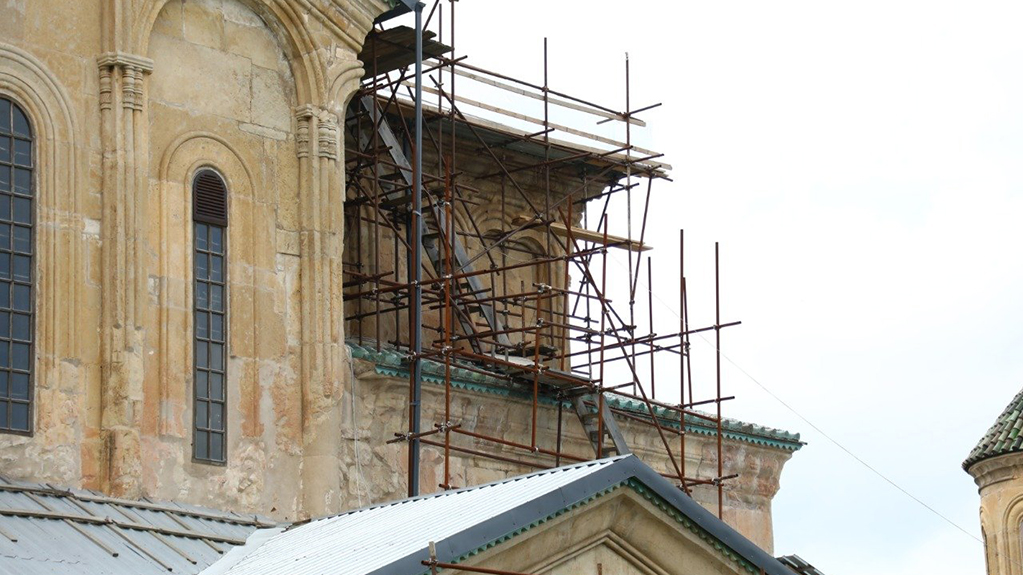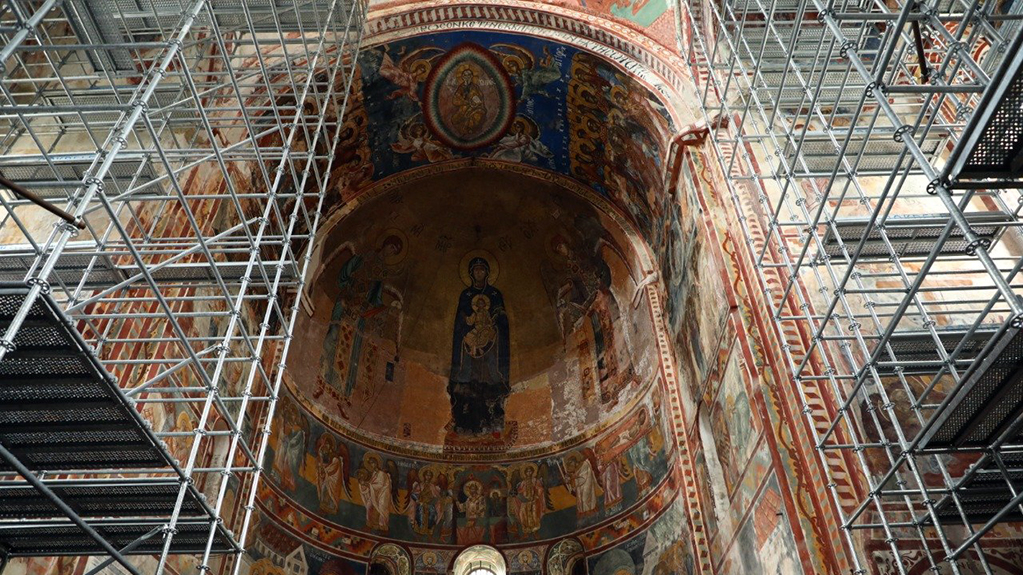“It is clear enough that if the development of processes with Gelati paintings is maintained in this way, the prospect of destroying this unique treasure of Georgian spiritual and material heritage is absolutely real,” - George Chubinashvili National Research Centre for Georgian Art History and Heritage Preservation, which is subordinate to the Ministry of Culture and Monuments Protection, publishes a critical and alarming conclusion on the problems of conservation of the World Heritage Monument, Gelati painted temples. In the report, which was prepared on the basis of the appeal of the Patriarchate of the Orthodox Church, a number of facts containing signs of a criminal offense were revealed.
News
Trending stories
- 1 BBC investigation: WWI–Era Chemical Weapons Used to Disperse Tbilisi Protests
- 2 Starting in 2026, First-Year Students at Private Universities Will No Longer Receive State Grants
- 3 NGOs Demand Answers on Which Chemical Substances MIA Used Against Protesters
- 4 Kobakhidze and Putin Attend International Forum on Neutrality in Turkmenistan
- 5 Zurabishvili Appeals to International Organisations to Investigate Possible Use of “Camite”
- 6 The Strasbourg Court Has Begun the Substantive Hearing of Gela Mtivlishvili's Case
In 2008 in Gelati large-scale design and rehabilitation works started. In 2010-2011, small buildings were covered with glazed roof tiles - the bell tower and St. Nikolozi Church, then the dome of St. George's Church, and finally, in 2016-2019 - the Great Cathedral. On the basis of the material discovered during the archaeological excavations in the territory of the monastery, it is assumed that the monastery buildings, including the great temple, should have originally had glazed roof tiles.
The poor quality of the glazed roof tiles (especially the white tiles) used for covering the Great monastery has been repeatedly noted in expert reports.
According to the experts of Chubinashvili Center, the method and quality of laying the tiles and arranging the roof was even worse -
The work was done by unqualified people without a preliminary project. The reason for water leaking into the roof was not only poor-quality tiles, but also unprofessional laying, incorrectly made gutters, joints and connections with the walls.
“Carelessly done work is visible even with a superficial inspection - in the places where the glazed tiles are conjoined and connected to the walls, inorganic materials incompatible with the authentic material are abundantly used: silicone, foam-filler, cement or a mixture of cement and lime. Naturally, the monolithic unity of the roof could not have been ensured with such materials.
As a result, tens of liters of water got into the walls and vaults during every heavy rain for several years. Sometimes the water found its way and poured into the interior (for example, from the south-west sail), and the largest part was absorbed by the building, which had a severe effect on the wall paintings.“
National Research Centre for Georgian Art History and Heritage Preservation calls it a methodological error to arrange the tile roof not on the wooden eaves, which create an attic and provide the opportunity for free ventilation of the building, but on a single solid mass that completely fills the space between the vaults and the roof:
“This filling mass is created with different materials (cement foam, pumice, construction waste, etc.) in different parts of the monastery and decisions about the material were made on the go, namely, without a preliminary project (In 2021 invited experts Ugo Tonietti and Sara Stefanini had to determine the filling materials for the roof based on the oral information of the craftsman working there, because they were not provided with proper documentation). After the water seeped in, in many places this material itself seeped and together with the walls, created a large additional damp mass. According to Ugo Tonietti and Sara Stefanini, this mass acts as a “wet coating” on the temple.
Nails were used to fasten the glazed tiles to the roof slopes, which is a common practice and has been known in Georgian church construction since at least the tenth century (Khakhuli, Oshki). Proper attention to quality was not paid here either - currently the nails are rusted in many places.
Since 2020, the building of the main temple of Gelati has been covered with a temporary tin roof, which is covered with glazed tiles on top. It protects the building from water infiltration, but prevents the drying process of walls and arches. While installing the temporary roof, the same mistake that was made when laying the tiles was repeated - it was not protruded enough from the walls.
Some of the water pipes of the temporary roof cannot ensure the proper transfer of water from the roof, rather, some of them are already damaged and have been plastered.
The glazed tile roof is not removed from the other parts of the temple. Partial removal of the roof caused the problem of uneven drying of the building. Evaporation of moisture went created additional problems for the painting of the wall of the western arm.

Specialists of the Chubinashvili Center also developed recommendations, according to which a solid temporary roof should be arranged on the main and St. George's churches in Gelati. In summer 2020 the NATIONAL AGENCY FOR CULTURAL HERITAGE PRESERVATION GEORGIA refused it with a reason that , if they considered the strong wind characteristic of Gelati, it was associated with risks - if the wind were make fall such a large structure, then it would cause great damage to the Monastery. According to the Chubinashvili Center recommendation, temporary roofing at all stages should be designed and implemented by highly qualified international specialists with relevant experience.
“t is essential for the building to be completely freed from the roof, so that the drying process of the walls and vaults can proceed evenly, and no longer does the concentration of evaporative moisture occur in separate places, as is happening now. It may take three to five years for the walls of the Gelati Temple to completely dry, as each 25 cm of the building's fabric takes about a year to dry. Period, when a new permanent roof should be made, can only be determined by observing the processes and further studies,” the report said.
The Chubinashvili Center criticizes the Ministry of Culture for the fact that the process of making decisions regarding the Gelati Monastery is extremely centralized and non-transparent: “The scientific methodological component (councils, reviewing, etc.) existing in previous years is now neglected at all stages. The work evaluation criteria and mechanism are unknown. The documentation describing the works, contrary to the international standards for the management of World Heritage sites and the requirements of a number of international charters, is difficult to obtain even for professionals and perhaps even unknown. The clear requirements regarding Gelati in the resolution of the 44th session of the World Heritage Committee held on July 16-31, 2021 have not been fulfilled yet:
- There is no monument management committee;
- The monument's management plan is not in effect, which already needs substantial updating;
- A conservation plan for the monument has not been developed, and the work is being done in a chaotic and fragmented manner;
- Regarding the issues of Gelati, the role of the World Heritage Council under the NATIONAL AGENCY FOR CULTURAL HERITAGE PRESERVATION GEORGIA is completely formal;
- simultaneous Coverage of Painted Temples has not been arranged.”
Authors of the report single out the intervention of restorers on the original plasterwork in Gelati as an extremely disturbing methodological violation – “replacing the historical reality with the reality interpreted by them is essentially a falsification of painting and damages the appearance of the world heritage monument.”
The situation is aggravated by the fact that the offensive interventions of the authentic face of Western Arm painting were carried out in secret from the professional circle- it did not go through any hoops of professional evaluation, review or approval.
In the system of protection of monuments, the professional circles that have always existed with certain variations since the Soviet times and which evaluated the scientific methodology of painting, are now abolished. Documentation about the performed works is not available, existing report does not say anything about the restoration interventions. No official information has been released anywhere. Regarding Gelati paintings, almost all the statements of the Fieldleaders are about urgent measures. Nobody talked about restoration-reconstruction, let even complete conservation. It is worth noting that the information about the works is not included in the texts of the agreements either, in the agreements, the "full conservation" of the paintings of the West Arm is defined as the object of purchase, and not - the restoration, which is carried out in the form of schematic and chromatic restorations.
This kind of arbitrariness, artistic interpretations based on the taste of individual restorers, is not only a violation of painting, an authentic face and a violation of international standards, but also grossly violates professional ethics. The situation is aggravated by the fact that the works are performed unstable environmental conditions and ongoing active damage to the painting. It is significant that the damage activation process, in the form of crystallization of salt, loosening or exfoliation of the painting layer, is already visible in the restored sections of painting a few months after the completion of the works.
In the end, results of Gelati painting conservation and restoration should be assessed as alarming and extremely worrying - especially since there is no doubt that, over time, the negative effect of the conservation and restoration works conducted with the wrong methodology will increase, especially with the background of the overlapping issue that has not been resolved to this day.”
The Prosecutor General's Office told “Sakartvelos Ambebi” that the investigation service of the Ministry of Finance has started an investigation into the possible crimes committed in Gelati Monastery.















